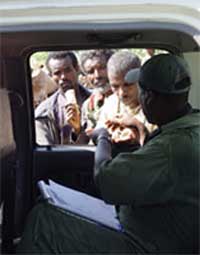|
Study design Calves born to cows monitored in the study were ear tagged and monitored subsequently along with their mothers. During the study the numbers of animals being monitored reached over 700. This was an excessive number to sample for the purpose of this particular study but they were nevertheless valuable for other purposes. The study was, in a sense, participatory, as it relied on farmers bringing their cattle regularly for weighing and blood sampling. They in turn received free treatment for infected and sick animals. Indeed some farmers worked with the researchers in weighing the cattle and giving the treatment. Farmers received pour-on treatments free monthly during this trial, but, in a parallel trial, farmers paid (Rowlands et al., 1999). That trial depended on farmers' willingness to pay, which in turn depended on their recognition of the benefits of treatment. |
Thus, when working in such an environment, it is often important to consider both the research objectives themselves and the interests of the community within which one is working. Indeed the researchers often relied on the perception of the participating farmers on how the project was progressing.
|
